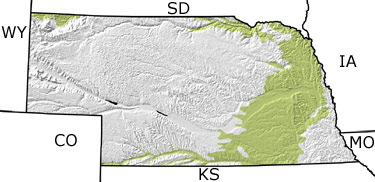Paleontology and geologyIn the Early Cretaceous, shallow seas slowly progressed inland from the southeast to the north and west and formed the Western Interior Seaway. The sea level fluctuated throughout the Cretaceous. Dinosaurs roamed the sandy coastal plains along the shores of the rising sea. Some of the earliest flowering plants, as well as leafy trees, grew on the coastal plain, and Pteranodon flew overhead. As the sea rose, Inoceramus, a large clam up to a foot across, dominated shallow water invertebrate communities. Shales and chalks from the deeper waters offshore contain fossils of large vertebrates, including mosasaurs, Elasmosaurus (a plesiosaur), giant sea turtles, sharks, and fish. The chalk also contains the remains of billions of microscopic fossils. The Late Cretaceous Pierre Shale is famous for its fossils of ammonites, which swam in open ocean waters like modern nautiloids. |

